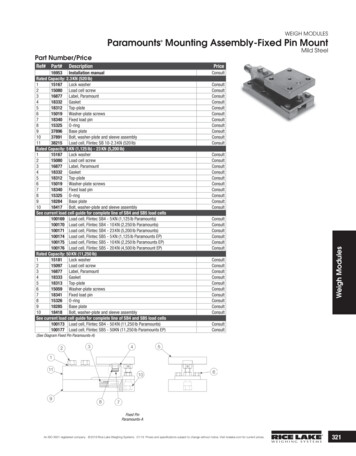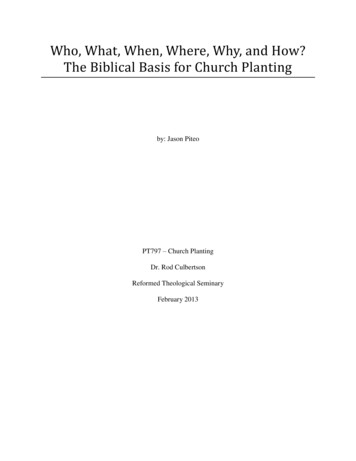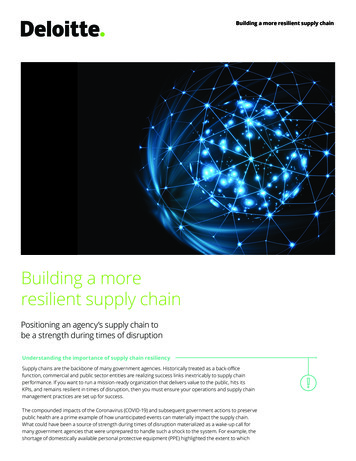
Transcription
UNSUSTAINABLE?The Growth of App-Based Ride Services andTraffic, Travel and the Future of New York CityFEBRUARY 27, 2017SCHALLERCONSULTING94 Windsor Place, Brooklyn NY 11215718 768 m
This report was prepared by Bruce Schaller, Principal of Schaller Consulting. Mr. Schaller has 30 years ofexperience on urban transportation policy and operations as a consultant and senior local government official.He served as Deputy Commissioner for Traffic and Planning at the New York City Department of Transportationand held managerial responsibilities at the NYC Taxi and Limousine Commission and MTA NYC Transit. He hasconducted studies for the U.S. Department of Transportation and for local governments throughout the countryon transportation, transit and vehicle-for-hire issues. He is the co-author of a 2015 National Academy ofSciences report on emerging mobility providers, and served as an Advisor for the City of New York's study of forhire vehicle issues. He has been called "a widely acknowledged expert" on issues related to taxis, Uber and Lyft(Politico) and a "nationally recognized expert in the cab business" (Washington Post). Mr. Schaller haspublished extensively in peer-reviewed academic journals including Transport Policy, Transportation and theJournal of Public Transportation.This report was researched and written by Mr. Schaller for the purpose of furthering public understanding anddiscussion of the role that app-based ride services and other vehicle-for-hire services can and should play infurthering urban mobility, safety and environmental goals. The author would like to thank staff at the Taxi andLimousine Commission, NYC Department of Transportation and MTA NYC Transit who provided information andinsight for the analysis. The analysis and conclusions are the sole responsibility of the author.
UNSUSTAINABLE? The Growth of App-Based Ride Services and Traffic, Travel and the Future of New York CityContentsSummary . 1Introduction . 31. Methodology . 62. Findings . 93. Travel, Traffic, Safety and Environmental Impacts . 174. Policy Responses . 225. Conclusion . 27Appendix A. Supplemental Figures and Tables. 28Appendix B. Personal Use of Vehicles by Drivers and Passengers. 31Endnotes . 33Boxes:TNCs and autonomous vehicles . 5These findings and the City FHV study . 16SCHALLER CONSULTINGi
UNSUSTAINABLE? The Growth of App-Based Ride Services and Traffic, Travel and the Future of New York City[This page intentionally blank]SCHALLER CONSULTINGii
UNSUSTAINABLE? The Growth of App-Based Ride Services and Traffic, Travel and the Future of New York City1SummaryThe rapid growth of app-based ride services such as Uber andLyft has raised both hopes and fears for their role in Americancities.These services are widely embraced as a newtransportation option that offers a higher level of availability,reliability and ease-of-use than traditional taxi and transitservices. Patrons also avoid the cost and inconvenience ofparking one's own vehicle. But the rise of app-based rideservices has also raised widespread concerns about their effectson traffic congestion and vehicle emissions and also about theirpotential to undermine public transit and taxi services that areessential components of urban transportation networks.The overarching question is how app-based ride services, alsocalled Transportation Network Companies (TNCs), mightsupport or obstruct goals for mobility, safety andenvironmental sustainability.The dearth of factualinformation available to date, however, provides little basis toassess the impacts of app-based ride services or decidewhether public policy is needed in any of these areas.This report presents findings from a detailed analysis of thegrowth of app-based ride services in New York City, theirimpacts on traffic, travel patterns and vehicle mileage since2013, and implications for policy makers. The analysis utilizestrip and mileage data that are uniquely available in New YorkCity, providing a detailed and comprehensive look at theexpansion of app-based ride services and their impact oncritical City goals for mobility, economic growth andenvironmental sustainability. and for-hire ridership outpaced growth in transit (subwayand bus) ridership and is now the leading source of growthin non-auto travel in New York City. This marks a reversalfrom the transit-oriented growth that lasted from 1990 to2014. TNCs transported 15 million passengers per month in Fallthree years, after accounting for declines in yellow cabmileage and mileage in personal vehicles. The additional600 million miles exceeds the total mileage driven byyellow cabs in Manhattan. of total citywide mileage from 2013 to 2016. (The industrymileage includes transportation of passengers, "dead-head"miles between dropping off one passenger and picking upthe next passenger, and drivers' personal use of driverowned vehicles.) by all vehicles, an increase of the same magnitude as the2007 congestion pricing proposal would have decreasedvehicle miles traveled. After accounting for declines in yellow cab, black car andcar service ridership, TNCs have generated net increases of31 million trips and 52 million passengers since 2013.Since mid-2015 TNCs have offered and heavily promoted"pooled" options such as UberPool and LyftLine.TNCmileage nonetheless continues to grow rapidly becauseexclusive-ride trips still predominate, and because mostTNC customers are coming from transit, walking andbiking.Migration from public transit translates toincreased mileage even if the trips are shared. Growth in trips, passengers and mileage is seen throughoutthe city as TNCs attracted yellow cab riders, those whowould otherwise use the bus, subway or their personalvehicle, and people who would not otherwise have madeTNC ridership tripled between June 2015 (the end of theVehicle Transportation Study) and the fall of 2016.In Manhattan, western Queens and western Brooklyn,TNCs added an estimated 7 percent to existing miles drivencab industry -- in 43,000 licensed vehicles.period examined by the City of New York's For-HireTotal mileage of TNCs, yellow cabs, black cars and carservices combined increased from 14 percent to 19 percent2016 -- nearly as many trips as served by the city's yellow TNCs accounted for the addition of 600 million miles ofvehicular travel to the city's roadway network over the pastFindings from this analysis show that TNCs have become animportant and fast-growing part of the city's transportationsystem. In each of the last two years, they have been theleading source of growth in non-auto (i.e., non-personal car)travel in the city. They have also added significantly tovehicular travel and mileage on city streets. Key findings are: In 2015 and to an even greater extent in 2016, growth in taxithe trip. Trip growth in Manhattan has been concentrated duringthe morning and evening peak periods, when yellow cabshift changes produced a shortage of cab availability, andlate evenings and weekends when passengers may preferSCHALLER CONSULTING
UNSUSTAINABLE? The Growth of App-Based Ride Services and Traffic, Travel and the Future of New York Citythe comfort and convenience of TNCs over yellow cabs ortransit services.Rapid TNC growth raises important questions about the abilityof New York City's transportation system to support the city'seconomic and population growth. From 1990 to 2014, thesubway and bus system absorbed all or nearly all the growthof travel in the city generated by increases in population andeconomic activity. The city depended on the transit system toabsorb the growth in travel since already-congested streetscould not accommodate the increased traffic that would occurif growth were channeled to the automobile.A continuation of TNC-led growth in travel is not a sustainableway to grow the city. Adding TNC mileage to alreadycongested streets will lead to mounting costs for businessesand consumers from increasing traffic delay and hinderprogress toward the City's goals for mobility, economic growthand the environment.City and transit officials can take a variety of steps to addressthe rising attractiveness of TNCs while also supporting themobility benefits that TNCs clearly offer. These include manyinitiatives already underway to improve the speed, reliability,comfort and ease-of-use of bus and subway service and thecomfort and safety of cyclists and pedestrians. Examplesinclude count-down clocks, dedicated bus and bike lanes andtrain signaling systems that enable more through-put ofsubway cars. But more needs to be and can be done.Additional steps can include adapting traffic signal timing tomake bus and bike speeds competitive with auto speeds, andreducing bus delay with off-board fare collection on busyroutes when the MetroCard fare payment system is replaced.2to the subject of road pricing. The City has historically usedpricing of taxicab fares and parking to discourage auto use inManhattan. As they steadily cut fares, TNCs are erasing theselongstanding financial disincentives for traveling by motorvehicle in Manhattan. If TNC growth continues at the currentpace (and there is no sign of it leveling off), the necessity ofsome type of road pricing will become more and more evident.Technological innovations have created new options for designand implementation of a road pricing system that targets themost inefficient use of scarce road space during the times andon the streets where additional vehicles contribute the most totraffic delays. There are thus practical opportunities forofficials to design, test and gain public acceptance of a roadpricing scheme carefully targeted to reducing unnecessarytraffic congestion.Although this report is specific to New York City, the findingshave important implications for other major American cities.The findings show that as TNCs grow, they are becomingcentral to changes in how people travel within dense urbanareas, with potentially far-reaching implications. How theyaffect traffic and transit is shaped by the availability andattractiveness of existing transit, taxi and other for-hireservices, which vary by city, location and time of day. Evenwhere TNC trips replace personal auto trips, TNC growth cangenerate additional mileage on city streets because of deadheading to pick-up locations and drivers' personal use of thevehicle. There is thus a strong need for a public policyresponse to the growth of TNCs. Developing a policy responseshould utilize trip data from TNCs, taxis and other for-hireservices, as is currently possible in New York.Streetmanagement, transit services and road pricing should all beexamined in formulating a policy response.Continued TNC growth, particularly as that growth becomesincreasingly fueled by low fares, also raises the need to returnSCHALLER CONSULTING
UNSUSTAINABLE? The Growth of App-Based Ride Services and Traffic, Travel and the Future of New York City3IntroductionApp-based ride services like Uber and Lyft have grown rapidlyin New York City, as across the country, since they beganoffering on-demand rides just a few years ago. The number oflicensed vehicles affiliated with these app-based services,which are also called Transportation Network Companies(TNCs), more than doubled in each of the past four years inNew York City, a pattern seen in other major cities fromBoston to Los Angeles.1The popularity and growth of TNCs is driven by their readyavailability, speed of travel, comfort and convenience,particularly for social and recreational trips or traveling to orfrom an airport. Customers say that taking a TNC saves timeand reduces stress while offering affordable fares. They useTNCs when they are in a rush, when it can be hard to get a cab,when public transit is not available or parking is difficult, aswell as to avoid driving after drinking.2TNC usage is becoming increasingly widespread. A recent online survey found that 38 percent of smartphone users in theUnited States have taken a TNC at least once, about half ofwhom use a TNC at least once a month.3Customer satisfaction appears to be high; an independentsurvey found that 78 percent of Uber users say they areextremely or very satisfied with the service while only 3percent are slightly or not satisfied at all.4 While taxi andsedan services have long provided the same basic service -- aride from point A to point B -- the ease, comfort andtransparency of using Uber and other TNCs has felt like arevolution in transportation for many of their customers.Not only their customers, but also urban officials have highexpectations for the role that TNCs can play in supporting keycity goals for mobility, economic growth and theenvironmental. Embracing and working with app-basedmobility services is expected to enable cities of all sizes "toprovide a wide range of mobility options than can utilize roadspace more efficiently and mitigate congestion."5 In New York,"shared-use mobility" is a key element in plans to reducegreenhouse gas emissions, expand opportunities for walkingand biking and facilitate faster bus service.6TNCs clearly intend to help achieve these goals. An Uberspokesperson said that by "getting more butts into thebackseats of fewer cars," his company and other TNCs help notonly their customers get around, but improve traffic andreduce emissions overall. When Uber first announced flatfares for pooled rides in Manhattan, it said that its "goal issimple: take 1 million cars off the road in New York City andhelp eliminate our city’s congestion problem for good."7 Lyftsays that customers sharing rides "are helping to reduce thecarbon footprint left by our country’s dominant mode oftransportation – driving alone."8Yet even as city officials and TNCs themselves view app-basedride services as part of the solution to crowded roadways,there are increasing concerns over TNC impacts on trafficcongestion, transit services and vehicle emission levels. Theseconcerns came to prominence in New York City in June 2015,when New York City Mayor Bill de Blasio proposed amoratorium on TNC growth to give the City time to assess thecauses of rapidly increasing congestion in Manhattan.Although Uber and Lyft were able to block a moratorium, theCity proceeded with its planned study and released a report inJanuary 2016.Surprising many people, the City's For-Hire VehicleTransportation Study (FHV study) concluded that TNCs were"a contributor to overall congestion, but did not drive therecent increase in congestion in the CBD."9 The analysisshowed that worsening congestion was driven primarily byincreased freight movement, construction activity, pedestrianvolumes and record levels of tourism, all of which put growingdemands on the streets' limited capacity.The New York City report also noted that TNC growth "coulddrive modest growth in congestion in the future" if it drewcustomers from public transportation. Partly due to thispossibility, concerns over TNC impacts in large cities haveintensified over the last year.An association of citytransportation officials released a policy statement in June 2016that, while recognizing the mobility benefits brought by TNCs,also stated that "the growth of ride-hailing services has hadand may have negative impacts on city transportation and theenvironment."10 The statement cited congestion, emissions andaccess for people with disabilities and disadvantaged personsas key concerns. In December 2016, the City of San Franciscoappealed to the state agency that regulates TNCs in Californiato conduct an environmental impact study of TNCs, writingthat, “Much of the increase San Francisco has experienced invehicular traffic can be attributed to the huge increase in thenumber of [TNC] vehicles operating on city streets.”11Recent national trends have given further reason for concernabout traffic, transit and environmental trends. After nineSCHALLER CONSULTING
UNSUSTAINABLE? The Growth of App-Based Ride Services and Traffic, Travel and the Future of New York Cityyears of contraction, per capita vehicle miles traveled in theUnited States increased between the spring of 2014 and end of2016.12 Meanwhile, U.S. transit ridership reversed course inthe opposite direction, declining between the first half of 2014and first half of 2016.13Underlying both the concerns of urban officials and thesebroad national trends are basic questions about how TNCgrowth affects use of city streets and transit systems. Is TNCgrowth making more efficient use of scarce street space byputting more passengers in each vehicle? Or does it add totraffic by diverting people from high-capacity services such asrail and bus? The answers to these core questions largelydetermine whether TNCs are helping cities meet their goals forsustainable growth, or hindering or even obstructing citiesfrom reaching these goals.So far, the answer has not been clear. A 2015 NationalAcademy of Sciences report stated that how TNCs and othernew mobility services such as car share and bike share "affecttravel behavior and demand, the use of all other modes .[and] private vehicle ownership . remains to be seen".14 Theannouncement of a study by the Natural Resources DefenseCouncil and the University of California at Berkeley gainedmuch attention over a year ago because it plans to addressclimate and environmental impacts in five major urban areas,including New York, Los Angeles and San Francisco.154This report examines the core issues of TNC impacts on travelchoices, vehicular use and traffic congestion in New York Cityover the last several years. The analysis utilizes datasets onfleet size, trips and mileage that are uniquely available in NewYork City.The report provides the first detailed,comprehensive and data-driven look at the expansion of TNCoperations in a major American city. Findings are based ondirect measurement of trip volumes and vehicle mileage (fromin-vehicle systems and odometer readings taken at dingcomprehensive and accurate data. The analysis covers theentire universe of taxi, TNC and other for-hire vehicles, thustaking into account declines in trips and mileage among taxiand car services to calculate the overall growth of taxi/for-hireservices including TNCs.The report uses these data to document trends in trips,passengers and mileage from 2013 to 2016, the impacts ofTNCs on transit ridership, and overall growth in travel andimpacts on traffic congestion and vehicle emissions. Thereport also discusses public policies that could help mitigatetraffic, transit and environmental impacts of TNCs while alsopreserving their valuable enhancements to the city'stransportation network.The report concludes withimplications that other major cities can draw from the findingsfor New York.SCHALLER CONSULTING
UNSUSTAINABLE? The Growth of App-Based Ride Services and Traffic, Travel and the Future of New York CityTNCs and autonomous vehiclesThe arrival of autonomous vehicles in coming years is expected to bring myriad benefits to cities. Theserange from reduced traffic injuries and fatalities to reducing the use of single-occupant vehicles.The findings in this report are directly relevant to a central vision of how autonomous vehicles should bedeployed in dense urban settings -- namely, in fleets of shared autonomous vehicles that would provide ondemand transportation, much like TNCs today but without drivers. By eliminating the need to pay driversand or to park in dense city centers, shared autonomous vehicles (SAV) are envisioned to have a broad set ofbenefits to traffic and the environment. A widely-cited simulation model using trip patterns in Lisbon,Portugal found that if deployed in concert with existing rail service, SAVs could eliminate congestioncompletely, reduce emissions by one-third and reduce the space required for public parking by 95 percent.16Freed-up parking spaces could provide land for new housing and commercial buildings, increasing urbandensities and furthering sustainability goals. An SAV fleet could also be electrically powered, furtherreducing greenhouse gas and other vehicle emissions.Leavening this optimistic vision are a number of concerns. Combining low fares and fast trip-making,shared autonomous vehicles could attract transit users, negating the congestion benefits. 17 The transitionperiod is also likely to be perilous. Initial implementation of SAV service could easily increase vehiclemileage since there are fewer opportunities to fill vehicles with riders until SAVs becomes a predominantway of traveling. Travel simulations show a 5 to 11 percent increase in vehicle mileage in the early stages ofdeployment.18 Add in a substantial shift from public transit, and increases in vehicle mileage could be muchhigher.19The arrival of fleets of shared autonomous vehicles may seem like a far-off possibility as no one knows howsoon autonomous vehicle technology may arrive at this scale.20 However, the same impacts -- good or bad -can arrive well before autonomous vehicle technology is sufficiently mature to operate in dense urbanenvironments. The modeling shows that changes in travel and vehicle mileage are generated primarilyfrom the combination of demand-responsive service and shared use of the vehicles, with automatedoperations being of secondary importance.21 In other words, the SAV future can arrive with continuedgrowth of TNCs driven by actual people. That future may thus be evident today, as documented in thisreport.SCHALLER CONSULTING5
UNSUSTAINABLE? The Growth of App-Based Ride Services and Traffic, Travel and the Future of New York City61. MethodologyThis report utilizes a series of datasets that are uniquelyavailable for TNCs, taxicabs and other for-hire vehicles in NewYork City. The availability of these data make possible themost in-depth examination of the growth of TNCs in anyAmerican city. This section describes the source data and howthey are used in this report.Data Sources1. Electronic trip logs. The most widely known data are triplogs for taxicabs and TNCs. These data have been widely usedby the press and researchers interested in taxi trip patterns inNew York. The trip logs include date, time and origin locationof each trip. Taxicab logs also include destination location,distance, duration and fare. Yellow cab data are available since2009; trip logs for TNCs are available starting in January 2015.22In addition to this ongoing reporting of taxi and TNC trips, theTaxi and Limousine Commission (TLC) has made publiclyavailable a file of Uber trips from selected months in 2014 and2015. This file was provided by Uber for the City's FHV studyin 2015. Unlike the ongoing data releases for TNCs, these datainclude trip destination, duration and distance.2. Weekly FHV trip volumes. In addition to trip logs, TLCmakes available weekly summaries of the number of trips andthe number of vehicles dispatched by for-hire vehicle (FHV)bases, including TNCs. 23 Data for TNCs are available startingin 2015. Other FHV bases have ramped up data reporting overthe past two years; most black car and car service bases arenow reporting data.3. Monthly taxi trip volumes. Monthly trips, fare revenue andother indicators are available for yellow and green cabs, postedin spreadsheets on TLC's website.244. Current licensees. Complementary to the trip files are listsof licensed taxicabs, FHV vehicles and FHV bases. Thelicensing files provide a snapshot in time of all licensedvehicles and bases. Current licensees are available on theCity's Open Data website.25 Licensing information for earlieryears was obtained using the internet archive "waybackmachine".265. Vehicle Mileage. TLC inspects each licensed taxicab andFHV vehicle periodically, ranging from every four months foryellow cabs to every two years for most FHVs. Vehicles areinspected at TLC's inspection facility in Queens. Odometerreadings from these inspections were obtained through aFreedom of Information request.Electronic trip log data are used for detailed analysis of trippatterns by geographic area and time of day. Due to thevoluminous nature of the trip data, the report utilizes datafrom three selected months: June 2013, June 2015 and June2016. The same month is used each year to avoid introducingseasonal effects on the analysis of trip patterns. Theseparticular months were selected because: June is a reasonably typical travel month, with moderateweather and no holidays. The last taxi fare increase was in September 2012. Usingdata for June 2013 means that trends in taxi trip patterns arenot affected by changes to the taxi fare. The City's FHV study relied on data through June 2015.Analysis for this report can thus look both at the timeframestudied in the City's report (pre-June 2015), and what hashappened since then. June 2016 was the latest month for which trip log data wasavailable at the time of analysis, enabling the analysis toreport the most up-to-date available data.For each of these June months, monthly totals are for 28 daysin each month (June 2 to June 29) so that there are consistently20 weekdays and 8 weekend days in each reported month.In addition to these trip and odometer data, the report relies onpublicly available data on travel in New York City. Each datasource is cited in the tables and figures where it is used. Themain sources are: Subway and bus ridership, provided by MTA New YorkCity Transit. Bike ridership, provided by New York City Department ofTransportation through 2015 and estimated for 2016. Ferry ridership, reported in the Mayor's ManagementReport. Personal travel by all modes, based on a household travelsurveyconductedfortheNewYorkTransportation Council (NYMTC) in 2010-11.SCHALLER CONSULTINGMetropolitan
UNSUSTAINABLE? The Growth of App-Based Ride Services and Traffic, Travel and the Future of New York City7Metrics and Analysis MethodIndustry sectorsThese source data are combined in various ways to produceresults for the following metrics. This section defines eachmetric and the source data used for it.These metrics are analyzed for total volumes (trips, passengersand mileage), changes over the last three years, and net changefor the taxi/for-hire industry as a whole. The net change isimportant to gauge the impact of TNC growth in the context ofoffsetting declines in yellow cab and sometimes FHV trips andmileage.Trips means trips with one or more fare-paying passengerstraveling as a group. Thus, two people traveling together frompoint A to point B constitutes one trip. For "pooled" TNC ridesusing UberPool, LyftLine and Via, each traveling party iscounted separately. Thus, when one person goes from point Ato point B, and the driver stops and picks up two passengersalong the way who travel from point C to point D, this iscounted as two trips (one from A to B, the second from C to D).Sources: Electronic trip data, weekly FHV trip volumes, andmonthly taxi trip volumes.Although the data TLC receives counts pooled trips, they arenot identified per se in the files TLC currently receives. Thereare press reports that about one-quarter or more of customersin New York benefit from pooled fares. However, customersselecting pooled options are not always matched with otherriders so the actual number of shared trips is lower.27 Under arecently adopted TLC rule, TNCs will be required to indicatewhich trips are pooled.Passengers and Ridership refer to the total number of fare-payingpassengers. Each passenger is counted separately even whentraveling together.Passenger volumes are based on the number of trips multipliedby the yellow cab average of 1.66 passengers per trip. The 1.66figure is used for TNCs as well as yellow cabs as TNC trip datado not show the number of passengers. It might be expectedthat TNCs have more passengers per trip given theirsomewhat different trip profile (more evening trips, greaterdistances). However, the yellow cab data show minimalvariation in per-trip passengers by time of day, and to thedegree that TNC traveling parties may generally have morepassengers, passengers usi
The Growth of App-Based Ride Services and Traffic, Travel and the Future of New York City FEBRUARY 27, 2017 SCHALLER CONSULTING 94 Windsor Place, Brooklyn NY 11215 718 768 3487 bruceschaller2@gmail.com www.schallerconsult.com This report was prepared by Bruce Schaller, Principal of Schaller Consulting. Mr.










